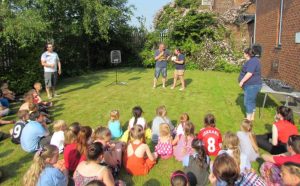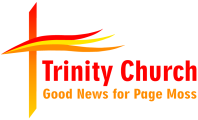Trinity Church – Growing and Going
Chapter 4 – The Rise and Fall in Church Life
During the war even paper was rationed, the Church bulletin for December 1944 was a few paragraphs on a single sheet of foolscap. It began: “we are sorry that paper being scarce, our letter this month must be short, but our greetings are as full and sincere as ever”. Later on it stated: “John Horne has returned from South Africa and has been detailed for duty under Coastal Command. Whilst on leave he, along with Ken Mills, shared in fellowship with us. Charles Cockayne has been recalled and John Parr has been called up for service in the Navy. Elliott Peers is married and our good friend Esther Murphy has become engaged. Our congratulations to her fiance, George Jones”. Sadly George Jones was killed only a few months later. Such were the horrors of war. A later bulletin announced that Robert Calder had been awarded the Military Medal for conspicuous bravery.
After the war, the first major outreach came in the form of a do-it-yourself mission during lent 1946, when Bernard Jones was the minister. He urged his flock; “Unless this campaign is a campaign of the whole church, it will not be as successful as it might be”.
A Disciples’ Roll Book was started in 1953 and the first name in it was Wendy Simmons, along with 23 other young people. Shortly after this, Sidney Tong became the minister and this is how he describes Liverpool and the Trinity People; “Liverpool was still something of a thriving port, busy rebuilding after the war, although already dogged by a great deal of industrial unrest. The Clean Air Bill was not yet operating, so we had some very bad smog conditions to deal with. Many a journey back to Old Swan proved quite hazardous. Liverpool Road Church was a lively, sometimes fractious, community of delightful honest to goodness people. Life for many of them was tough, and the Sunday School was crowded with youngsters needing somewhere to go on a Sunday afternoon.
During this time Roland Colbert put forward the idea of a new church building and managed to steer it through the Circuit. Membership reached its highest of 150 in the mid-fifties, but by 1963 this had fallen to 137, to 80 in 1976 and just 60 in 1984. Twenty years ago the Youth Club could boast a regular attendance of 60, whilst 46 were members of the Bright Hour. Nowadays, sadly, the youth club is no more. It was closed in 1972 due to its lack of leadership. The Bright Hour has only 15 members at present, but this is bolstered by a further 20 in the Women’s Fellowship, an evening group.

The church building, erected in the 1950s
Amongst new members received on September 6th 1964 was Bob Gilston, who later became a youth leader in Hartford, near Northwich. Prior to 1964 David Redrobe had been accepted for the ministry, and Helena Prince, a regular Sunday School scholar, became a Deaconess in the Anglican Church in West Derby.
Now to money matters.
In 1963 the average collection was 22 pounds and 10 shillings.
In 1968 the average collection was 19 pounds and 14 shillings and 8 pence.
In 1972 the average was still only 20 pounds and 31 pence per week.
The first real increase was in 1974 when records show an average collection of 24 pounds and 72 pence. In 1983 the weekly offering was 51 pounds and 5 pence which was much more heartening, whilst the annual turnover was almost 9,000 pounds!
Problems had mounted for Alf Shannahan after he became minister in 1967. The minutes of the leaders’ meeting on May 27th 1968 reveal that “the business meeting concluded at 9:15pm and the next hour was taken up by the minister who talked at length on the overwhelming spirit of discontent, apathy, and disloyalty in the church at the moment. Mr Shannahan said he had been stunned by the vast number of resignations he had received in the nine months he had been with us. He warned us that if we didn’t have a change of heart very soon, Trinity would be beyond help”. Certainly, attendances at Sunday worship were poor at this time; the average number taking Communion were only 26 in 1968. The minutes of a Trustees’ Meeting for 22nd October 1968 close like this: “There being no further business, Mr Shannahan closed the meeting with prayer at 10:45pm”. Those were the days!
Further concern was expressed in 1973 when numbers attending Sunday School totalled only 60 from all departments. The whole mission of the Church was studied prayerfully. In the same year several Churches in Huyton were caught up in the “Call to the North” campaign which culminated in a united Procession of Witness to Dovecot Park on Good Friday.
In 1974 Methodism as a whole underwent ‘Re-structuring’. The theory was that all able-bodied leaders in a church would become more effective by being part of more streamlined committees. Ken Anderson was minister at this time; one of his observations was “The danger at Trinity is that all our resources are put into the business of survival”.
Although our premises had sustained periodic damages over a number of years, the word ‘vandalism’ is mentioned for the first time in the minutes of 11th May 1971. Extra police protection was promised, but in 1976 evening worship was discontinued due to poor attendances. Some people were, understandably, too frightened to come out. Willful damage, mainly by young people, continued, break-ins were numerous. More and more windows had to be bricked up. Metal facing was fixed to the doors with a giant, impregnable (we pray) lock, giving us the grim image of Fort Knox rather than a place of worship! In March 1981 the Fire Brigade summoned Roy Hardiman, the property steward, and Malcolm Carter, the minister, from their beds. Trinity had been set on fire. They remember standing in inches of water in the beautiful hall. The fireman prevented the flames from spreading to the Sanctuary but thousands of pounds worth of damage resulted and the Methodist Insurance Company informed us that Trinity was the highest claimant in Great Britain, an unenviable distinction. Trinity is currently insured for almost half a million pounds.

Inside the church building, mid 1980s
More recently large, ugly lettering declaring the innocence of a certain prison inmate deface the exterior wall of the Church, while fourteen car tyres were discovered slashed at the close of one Sunday’s morning worship. The latest incident to date was a stolen van driven off the main Liverpool Road straight up our path to the Church’s front door and then set on fire! Our steel doors withstood the flames.
In 1977, after much thought and discussion, a Job Creation Scheme was established at Trinity. The skills offered to the community were painting and decorating and gardening. There were undoubtedly teething difficulties, but gradually a good working relationship was built up. Trinity benefitted considerably, not only through the added income, but also through the repair work of all kinds done on the spot at material cost only. Sadly the scheme folded in 1983, due to union problems. Our premises had at one time helped to provide employment for over 80 young people; we were pleased that several subsequently found full-time employment.
In the past year our finances have been drastically reduced by expensive roof repairs and our Superintendent has recommended Trinity for a grant from the ‘Mission alongside the Poor’ fund.
In 1982 we had a period of mission at Trinity over several months culminating at Easter. Four students from Hartley Victoria College came to work with us: Ray Lunt, Jeanette Lambrick, David Archer and Keith Albans. They proved to be an excellent team, though they only underlined our lay leadership deficiencies. However, our people were constantly reminded of what the mission of the church is. We were all thrown back on to the essentials – worship and preaching, pastoral caring, social involvement and family togetherness. It was a mission to the fringe; everyone with the feeblest link with Trinity was visited and challenged. Our people were built up in faith. Not least the mission was a great benefit to the students, because they operated in a tough area and were confronted with the very real problems at the onset of their own ministry. On the final night of the mission a fire extinguisher was stolen from the Church! Fortunately our re-kindled faith was unaffected.
Earlier in 1978, shortly after the arrival of Malcolm Carter at Trinity, he was asked to choose one lay person from Trinity to go and meet Her Majesty, Queen Elizabeth II at Kirby, of all places! He hastens to add that 500 other people were invited as well. The occasion was her visit to Liverpool when the Anglican Cathedral was at last officially opened. The Council of Churches felt she needed to see some of the less glamorous sights of Liverpool as well, and rightly so. It proved a most memorable occasion for all, especially Trinity’s young Sunday School teacher Mrs. Linda White.

Linda White on her way to meet the Queen
Another most memorable trip for Trinity folk took place in September 1979 when, with Court Hey Church, two coach loads traveled to Epworth, the home of the Wesley’s. We were visibly reminded of our roots and John Wesley’s keenness to spread scriptural holiness throughout the land. In 1981 and 1983 Trinity had an exchange pastor to serve them, Rev. Jimmy Adams from Manning, South Carolina, and then Rev. Charles Sapp from Stillwater, Oklahoma. The experience widened all our horizons. We all had much to give and receive.
As this booklet is written 50 Trinity folk are booked to go by coach to the united service at Liverpool’s unique International Garden Festival in May. Another coach is booked ready for Billy Graham’s Mission England service at Anfield Football Stadium in July, when we hope to take friends and family with us to hear the gospel for themselves.
Before then, all at Trinity are eager to celebrate our Golden Anniversary with an open-air service on Saturday May 5th 1984. Methodism began in the open air and it is right that we should remind ourselves again of our roots. We hope the Salvation Army will come to our rescue and play the hymns for us on Liverpool Road! This will be followed by an anniversary buffet for former and present Trinity folk alike.
















